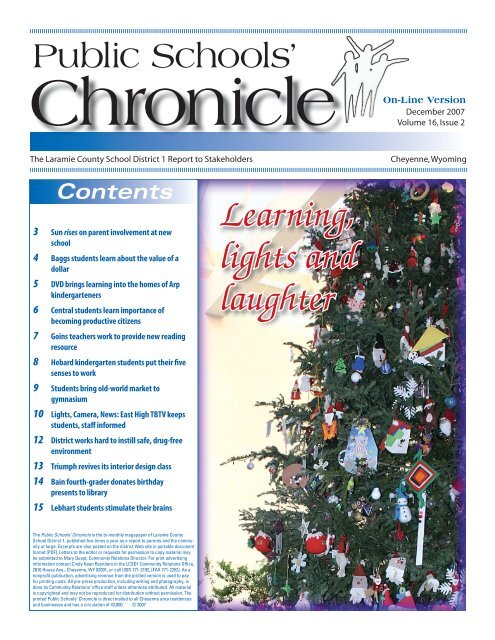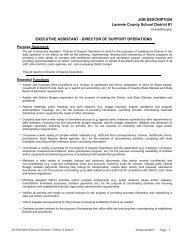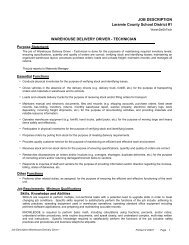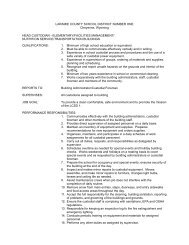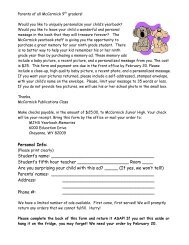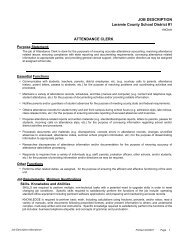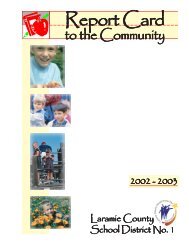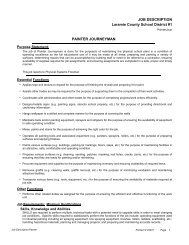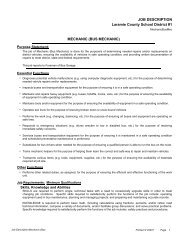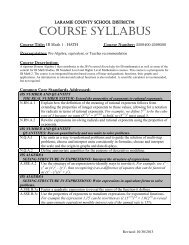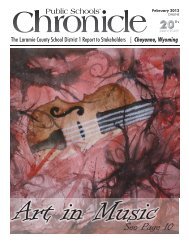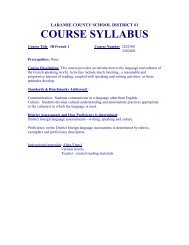Chronicle - Laramie County School District #01
Chronicle - Laramie County School District #01
Chronicle - Laramie County School District #01
Create successful ePaper yourself
Turn your PDF publications into a flip-book with our unique Google optimized e-Paper software.
Public <strong>School</strong>s’<strong>Chronicle</strong>DecemberOn-Line Version2007Volume 16, Issue 2The <strong>Laramie</strong> <strong>County</strong> <strong>School</strong> <strong>District</strong> 1 Report to StakeholdersCheyenne, WyomingContents3 Sun rises on parent involvement at newschool4 Baggs students learn about the value of adollar5 DVD brings learning into the homes of Arpkindergarteners6 Central students learn importance ofbecoming productive citizens7 Goins teachers work to provide new readingresource8 Hebard kindergarten students put their fivesenses to work9 Students bring old-world market togymnasium10 Lights, Camera, News: East High TBTV keepsstudents, staff informed12 <strong>District</strong> works hard to instill safe, drug-freeenvironment13 Triumph revives its interior design class14 Bain fourth-grader donates birthdaypresents to library15 Lebhart students stimulate their brainsLearning,lights andlaughterThe Public <strong>School</strong>s’ <strong>Chronicle</strong> is the bi-monthly magapaper of <strong>Laramie</strong> <strong>County</strong><strong>School</strong> <strong>District</strong> 1, published five times a year as a report to parents and the communityat large. Excerpts are also posted on the district Web site in portable documentformat [PDF]. Letters to the editor or requests for permission to copy material maybe submitted to Mary Quast, Community Relations Director. For print advertisinginformation contact Cindy Keen Reynders in the LCSD1 Community Relations Office,2810 House Ave., Cheyenne, WY 82001, or call (307) 771-2192, [FAX 771-2252]. As anonprofit publication, advertising revenue from the printed version is used to payfor printing costs. All pre-press production, including writing and photography, isdone by Community Relations’ office staff unless otherwise attributed. All materialis copyrighted and may not be reproduced for distribution without permission. Theprinted Public <strong>School</strong>s’ <strong>Chronicle</strong> is direct mailed to all Cheyenne area residencesand businesses and has a circulation of 43,000. © 2007
4 • December 2007 On-Line Public <strong>School</strong>s’ <strong>Chronicle</strong>Baggs students learnabout the value of a dollarMoney. Dinero. Yen. Euro. Tala. Inwhatever country, however you say it,dollars are important. No matter what pathwe choose in life, we all must learn to wiselymanage finances. The sooner, the better.Baggs Elementary sixth-grade teacherGeri Kraft believes it is important for youngpeople to understand how finances work.Recently Citi Financial representativesoffered to give a presentation to her class onthe basics of maintaining personal budgets.Kraft reviewed the presentation to decideif it would be relevant for her studentsand decided it was because of the basiccomputation skills involved in the exercises.“I thought it fit really well because we areanalyzing data in our first math unit,” sheexplained. “The exercise also has reading ofcharts, tables and analyzing data. The pieceI thought was important was the vocabularywhich the kids may not have used before.”Citi Financial representatives NickSundquist and Bronwyn Pflughoeft, whois a former LCSD1 student, visited Kraft’sclassroom armed with a stack of handouts onpersonal finances.One of the first things Pflughoeftdiscussed with students was the differencebetween “needs” and “wants.” Once thestudents understood what each of themmeant, she asked, “What is income?”She called on one of the students whoanswered, “How you get money.”Pflughoeft then questioned the class,“What is a budget?”Another student answered, “Somethingthat shows how you spend your money.”Now Pflughoeft wanted to know, “What isa balanced budget?”Another astute class member answered:“A balanced budget has a perfect amount ofneeds and wants so you get everything thatyou need. And if you have extra money, youget what you want.”“Correct,” Pflughoeft said.Pflughoeft and Sundquist discussed otherfinancial items such as expenses and cashrecords. Then they passed out sample budgetrecord forms for a fictional character namedAnn Hill.This exercise required students to sortthrough Hill’s needs and wants in orderto prioritize the needs, thenthe wants, so that the budgetcould be balanced. Working insmall groups, students intentlytalked about what Hill simplywanted and what she trulyneeded. For example, studentsdecided that food, a placeto live and medical expenseswere definite needs. Vacationaccounts and entertainmentwere wants.As the students poredover the information in theworksheets, adding andsubtracting, Kraft askedher students, “What are thenumbers on the sheet?”After a few moments, criesof recognition arose from thestudents. “Data,” they said inunison.“Right,” Kraft affirmed. “Isit numerical or categorical?”“Numerical,” the studentsconfirmed.Pflughoeft and Sundquisthanded out several more worksheets, withthe final one for the students to take homefor further reference.Kraft asked her class, “Is there anybody inhere who has a really big want, but you didn’thave the money, the cash record, to get it?”The students agreed that had happenedto them.“You’ve got to wait until the next payday,the next allowance or the next chorepayment in order to get it,” Kraft said.“What are some things you do to earnmoney?” Sundquist asked. “There’s lots ofdifferent things you can do. You can save upfor the things you want.”Hands shot in the air and studentsoffered what they do to earn money suchas mowing lawns, raking leaves, shovelingsnow, watering lawns, babysitting and paperroutes.Kraft was pleased her students were ableto focus on writing, vocabulary and math inthe exercises. She plans to have her studentswrite a reflection or summary about whatthey learned from the presentation. In theCiti Financial representative Nick Sundquist helps a student review a budgetsheet.report, which will receive a writing grade,students will be required to properly usepunctuation along with the monetaryvocabulary they learned; needs, wants,income, expenses, cash record and balanced.Kraft will also have students write thank youletters to Citi Financial Bank.“The other piece I thought was reallygood was they (bank representatives)sent home the worksheet to share withthe parents. It brought in the homeconnection.”When asked what he learned from thepresentation, one boy said, “I learnedthat keeping track of your money is moredifficult than it sounds.”Overall, Kraft thinks the bankpresentation was beneficial to her students.“It seemed to me the kids were engagedwith what was going on,” she said.“Collaboration between the community andthe schools is always a good idea.”—Photo & text byCindy Keen Reynders
On-Line Public <strong>School</strong>s’ <strong>Chronicle</strong>December 2007 • DVD brings learning into thehomes of Arp kindergartenersFamiliar voices and aconsistent message arehelping Arp kindergarteners andtheir parents take the learningexperience outside of theclassroom and into their livingroom.It’s all part of a projectinitiated by the kindergartenteaching team at ArpElementary. Erika Moncrief isan early childhood interventionspecialist for kindergarten LEEP(Language Early EnrichmentProgram). Sheexplained animportantcomponent of theprogram is promotingfamily involvement.“All summer I wasthinking ‘how can I doa better job at that?’ ”Moncrief said.And suddenly,when filming her ownchildren at home, shecame up with the ideato produce an interactivekindergarten DVD.Once she took it to theProfessional LearningCommunities (PLC)meetings at school, theproject took off.Kindergarten teacher BrandiBauer explained the DVDdelves into topics teachers areaddressing during the firsthalf of kindergarten. “We’rehoping to do another one forthe second half and featuredifferent skills,” she said.Lynette Grandpre, who alsoteaches kindergarten at Arp,explained the DVD is “just15 minutes long so it’s shortand sweet.” In other words,it’s long enough to instruct,yet short enough to keep littleeyes and ears interested in itscontent.Arp Elementary parent AllenBurd explained when his son,Tyler, brought the DVD home,he wasn’t the only one engagedin learning. Tyler’s 3-year-oldbrother began to do the exercisesas well.“He [little brother] wasdoing the sounds and using theletters,” Burd said.“It was pretty neat.”Topics on the DVDinclude the alphabet, days ofthe week, shapes, patterns,counting and colors. Accordingto those involved, it was alarge undertaking and terrificgroup effort. The school’sinstructional facilitators (IFs)Kaye Binning (language arts)and Lisa Esquibel (math) werealso instrumental in putting theproject together.“I think parents want tohelp their children,” Binningexplained, “but they don’talways know how to help themin the same way it’s done atschool.”The DVD is also being usedby the school’s pre-kindergartenteacher and at RossmanElementary.By expanding its use to pre-K students, Bauer said shethinks “it helps the parentsunderstand what to expectfor their kids to be workingon. They know what we’reexpecting when they come tokindergarten.”Children are taughtto recite theirABCs using thisinteractive DVD andcolorful letter sheet.Burd said it has been verybeneficial for him to have theDVD to help assist his sonswith their studies.“I think the biggest thingis that parents are able to seewhat is actually being taughtand to be involved a little bit,”he said.Esquibel explained the DVDwas specifically designed to“match the curriculum andessential skills.”Burd said Tyler enjoyedwatching and listening becauseof its familiarity. “I think heliked it because he recognizedthe voices,” he said. “It wasn’tjust a DVD we’d go pick up atthe store; it was familiar and itwas personal.”“There are a lot ofcommercial products out therebut some of them are prettypricey,” Moncrief agreed, “andthey may not be specific towhat we teach. A lot of familiesmay not have the resources togo and buy those so this givesthem something.”The teachers say theycouldn’t have produced thevideo without the help oftheir technology integrationspecialist and the district’smultimedia department. Sinceit was their first DVD, some ofthem chuckled about it lookingrather like a home movie. Yet,they all agreed they were happywith the final product.“All you see are hands andyou hear voices,” Bauer said.“We just borrowed the littlecamcorder and taped it rightin the classroom. We did it[taught the lessons] just theway we would do it if we hadthe kids in here.”Bauer said the DVD hasprovided teachers with anadditional way to communicatewith parents who may havequestions about how they canhelp their children.Moncrief added that parentswho play the DVD at home aresimply reinforcing the fact thatschool is important.“If kids see that it’simportant enough for theirparents to play it at home, thenthey are going to see school isimportant in their family andeducation is important in theirfamily,” she said.—Photo & text by Mary Quast
6 • December 2007 On-Line Public <strong>School</strong>s’ <strong>Chronicle</strong>Central students learn importanceof becoming productive citizensCheryl Miller, U.S. Geological Survey hydrologist, teaches geology students at Central High <strong>School</strong> aboutground water and the effects of polution on our drinking water supply.Geology students atCentral High <strong>School</strong>are learning more than thehydroelectric cycle and themeanings of porosity andpermeability—they arelearning to be productivecitizens.Central High science teacherJim Williams was awarded aCheyenne <strong>School</strong>s’ Foundationgrant for his applied geologyprogram. Williams said, “Thisproject will give studentshands-on geologic fieldexperience as it applies tothe economic landscape ofWyoming.”Along with learning aboutgeology, Williams stresses tohis students the importanceof taking care of the Earthand its water. “You are gettingclose to voting age,” Williamstells his students, “and someof these issues will be drivinglegislation—ground waterpollution and sedimentationfrom over-use of land.”As part of the grantprogram, students take amonthly analysis of the creekthat runs next to CentralHigh. Working in groups, theyextract water samples fromdifferent areas of the creek.Williams saidthis project helpsstudents developcritical thinking.After designing theinvestigation, “theydecided what wasimportant to monitorand they have learnedhow to adjust theirsample collecting asthe water has startedto disappear,” headded.Cheryl Miller, U.S.Geological Surveyhydrologist, providesstudents with amonthly lesson aboutwater and how it isimportant to each andevery person.She explained: “Thewater we have now isthe water we’ve alwayshad. The problem is itmay not be where wewant it or the qualitywe want it to be.”Miller described thehydroelectric cycleand showed studentshow sedimentation fromground use can cause groundwater to change paths and howpollution can contaminate theground water people pull fromtheir wells.Williams’ geology studentswill also take part in severalfield trips to the CheyenneWater Treatment Plant, theCrow Creek Waste WaterTreatment Plant, and roadsidegeology trips to examineCenozoic formations, whichhelped with the formation ofthe Ogallala Aquifer.“Most students have noprevious experience of fieldwork and the practicalitiesof making measurementsand observations,” hesaid. “Through hands-onexperience students will learnto relate regional structures togeophysical measurements andobservations.”The goal is for students tomake real-world connections,such as the search for energy,mineral and water resources,the evaluation of environmentalhazards and the preventionand/or prediction of naturaldisasters.The results of the creekmonitoring project will beposted to a national databaseon the Water EnvironmentFederation Web site in thespring. As part of World WaterMonitoring Day activities thattake place every fall, schoolsfrom around the world posttheir individual project resultsto the site.In order to give his studentsa better understanding of howthe water cycle works, Williamssaid they decided to conducttheir study throughout the yearinstead of the two-day periodgiven for the monitoring dayevents.During their November datacollection, the students beganto understand how water levelscan change drastically in a shortperiod of time. Their onceflowing creek was nearly dry.Several students commentedthey couldn’t believe how muchthe level had dropped in lessthan a month.One girl exclaimed, “It’sreally dirty and gross now. Itwasn’t like this last time.”—Photo & text byMontika Bunner
On-Line Public <strong>School</strong>s’ <strong>Chronicle</strong> December 2007 • 7Goins teachers work to provide new reading resourceAlthough most childrenhave never visiteda rain forest or, for thatmatter, looked through atelescope, the sixth-gradeteaching team at GoinsElementary is working tohelp them envision thoseexperiences through the useof Kid’s Discover magazine.According to sixth-gradeteacher Terri Mercer, themagazine is just one wayteachers at the school canprovide supplementalreading material to helpstudents develop a frameof reference for science andsocial studies.“The Kid’s Discovermagazines devote an entireissue to one topic, suchas ‘The Solar System’ or‘Lakes,’ ” Mercer said.“The pictures and text helpprovide the backgroundthat our kids need tounderstand the topics weare teaching.”Goins sixth-gradeteachers are also workingto devote more time toscience and social studiesby incorporating them intoguided reading.“We’ve been integratingsome of the subjects intoour reading groups,”sixth-grade teacher Chris Hallexplained. “The more materialsthat we have, the better.”By using the magazines asanother source of informationalong with the science book,Hall said he’s able to keep kidsengaged in learning.“The format is so kidfriendly,”Goins PrincipalJoyce Chalstrom said of themagazines.“I think one of the hardestparts for intermediate kids ismaking the transition fromnarrative text to expositorytext and learning how to useA Goins Elementary sixth-grade student looks through an issue of Kid’s Discover magazine. Teachers are usingthe magazine to broaden students’ knowledge base in science and social studies.textbooks,” Chalstrom said. “Alot of times we just hand thema textbook and expect them toknow what to do with it.“Magazines like Kid’sDiscover … they’re inviting,they’re exciting and goodteachers can take them andteach students how to use mainideas and supporting details anduse them as a transition stepinto big, thick textbooks.”It all seems to be paying offas Mercer and Chalstrom saidstudents are picking up themagazines to read for pleasure.Chalstrom said, “you hearstudents refer to what they’relearning from them in othersubject areas.”This enjoyment is echoedin sixth-graders’ comments.Andrew Miller said he’s enjoyedreading about “H2O.” CharlieGalloway said he likes the factthat when he’s finished readingabout the “big subject” he cango to the bottom of the page toretrieve more information listedin brief bullet points.Tamara Barnes said themagazines are interesting unlikethose that “our parents read.They’ve always got the subtopicsand they’re short paragraphs.The pictures are real nicetoo.”“I like the pictures becausethey’re interesting,” PeytonAlvarado said. “I like howthey show people in othercountries.”Mercer said one ofthe sixth-grade teachers’initiatives this year is tohelp students see howscience affects the bigpicture. “Science and socialstudies are connected toeverything else you do,”she said. “You’ve got toknow math to do scienceand you’ve got to be able toread to do social studies andyou’ve got to know politicsto make a good living, ina certain sense. So it’s allinterconnected and we’rereally trying to go with thatglobal view this year.”As part of that global view,Mercer has extended aninvitation to local businessesand community membersto help offset the costs ofthis endeavor. Many havestepped up to help theschool.For example, FrontierRefinery sponsored thepurchase of the “Energy”issues; Western StatesLearning Corporationsponsored “Pyramids” issues;and the Board of Public Utilitiessponsored “Water and Climate.”Mercer said Western VistaFederal Credit Union’s mortgagedepartment pooled theirmoney to donate 16 copies of“Microbes” because, they said,“sixth-graders aren’t the onlyones who don’t know whatmicrobes are.”“The public outpour fromthe community has beenheartening,” Chalstrom said.—Photo & text by Mary Quast
8 • December 2007 On-Line Public <strong>School</strong>s’ <strong>Chronicle</strong>Hebard kindergarten studentsput their five senses to workOn a recent field trip to CheyenneKing Soopers, Hebard Elementarykindergarten students put all five senses towork as they learned how a grocery storeoperates and how to make healthy choices.Pam Forbes, Hebard kindergarten teacher,said the class spent the whole month ofNovember studying the five senses and howto make healthy food choices. Their fieldtrip was the culminating activity to tie it alltogether.Throughout the month, students tasted,touched and smelled different foods. “Weencourage them to eat fruits and vegetables,”Forbes explained. “They also got to trybaker’s chocolate and different things thattasted bitter, sweet and sour.”At the store, their senses kicked intohigh gear. Kathy Dayhoff, King Soopersstore administrative assistant, lead the tour.Students listened eagerly as she took themfrom one area to another.The tour began in the produce sectionwhere kindergarteners could see manydifferent types of fruits and vegetables. Onestudent exclaimed, “Look at all the differentcolored apples.” Dayhoff also taught themthat potatoes are called “tubers,” and Brazilnuts come from Brazil.While showing kids the racks ofvegetables and explaining which oneswere the healthiest choices, Dayhoff askedstudents why they call that area the “wetrack.” After seeing the automated mistwith accompanying “thunder” noises justmoments before, a little boy stated “becauseit rains.”In the bakery, students saw how a breadslicingmachine works. This was a treatfor the kids who were especially interestedbecause they baked whole-wheat bread inclass, Forbes said. They will also make theirown butter with cream and salt in a babyfood jar.Dayhoff led the tour to the back areawhere only “very special guests” get togo she told the students. Students werefascinated by the big freezer and the chillyair pouring through the open door.“Brrr, that’s really cold,” one girl said.“You need a coat to go in there.”After the tour, students began shoppingfor ingredients to make “Stone Soup.”Forbes, who had previously read the storybook to her class, explained they wouldbuy similar ingredients for their own soup.Students eagerly helped Forbes choosehealthy vegetables.“Stone Soup is a fun way to incorporateliterature into the lesson.” Forbes said. “Inthe story townspeople use vegetables to maketheir soup. The characters talk about workingtogether and making soup for the wholetown that’s fit for a king. It’s fit for a kingbecause of all the good things they add to it.”The day after the field trip, students made“Stone Soup” in class. Although Forbes hadthe soup cooking when the students arrivedthat morning, she said, “They got to cut upthe celery with plastic knives.”“Ninety-eight percent of them really lovedthe soup,” she added, “even though it was allgood things.”Between shopping, making soup, bakingbread and churning butter, Forbes said:“We incorporate a lot of cooking into ourliterature and our math. We talk aboutmeasuring and touch on other core subjectsthat go across the curriculum.” Her goal isto give them opportunities they may not getat home.“We try to make learning part of reallife,” she said. “It just doesn’t happen insidethe four walls of the classroom. We try toextend it out and show them how it appliesto all the things they have done and aregoing to do.”—Photo & text by Montika BunnerHebard Elementary kindergarten teacher Pam Forbes teaches her students about healthy food choices and the difference innutrition between canned fruits and vegetables and the fresh ones.
On-Line Public <strong>School</strong>s’ <strong>Chronicle</strong> December 2007 • 9Students bringold-world marketto gymnasiumIt’s not every day you get totime travel to an ancientEgyptian marketplace andbow to the pharaoh. However,Jessup Elementary sixth-gradersrecently had the opportunityto do exactly that. With somehard work and imagination,the students transformed theirgymnasium into an old-worldmarketplace, complete withcolorful rugs, brass urns, exoticmusic and diverse foods.Sixth-grade teachers BridgetDubberley and Mark McIlvainhelped their classes bring thisevent to life by incorporatingthe students’ research of ancientEgyptian culture into their dailylessons. Art teacher Jane Kinderalso helped students makeauthentic Egyptian masks.Over the course of this unit,students studied how peopleexisted in this pyramid-dottedcivilization located alongthe banks of the Nile River.Students also learned about thesupreme authority of pharaohs,as well as the relationshipsbetween kings, nobles andcommoners.All of the students at Jessup’sEgyptian marketplace dressedin costumes resembling thelight linen tunics and dressesthat would have been wornby individuals in the hot,sunny climate. Egyptians lovedornamentation and manystudents wore bright collarsmade in art classes, elaborateturbans and other personaladornments.Student “merchants” kneltin stalls beside the goodsthey were “selling.” Trays offood tantalized, householddecorations invited and jewelryglittered. All walks of life wererepresented. Farmers, engineers,dancing girls and even a dreaminterpreter brought theirpersonalities to the affair.McIlvain opened the marketby announcing the arrival of thepharaoh and numerous othernobles. To the “merchants” headvised: “If you value havingyour head attached to yourshoulders, give the pharaohwhat he wants. Back then, if theupper class wanted something,you would give them a betterdeal. You should never look thepharaoh in the eye. To do soconstitutes death, so bow andshow respect.”Doors to the gym openedand students in elaboratecostumes and goldenembellished head-dressesentered to begin bartering forgoods.When they’d finished,McIlvain announced middleclassindividuals would now beallowed to shop. “Treat themwith respect,” McIlvain advised,“but they won’t get as good adeal.”The last group he announcedwas the lower class and thistime he advised, “As they shop,you don’t need to look themin the eye or treat them veryrespectfully.”Dubberley said manydifferent core subjects wereintegrated into this unit andthat the students were definitelyengaged in their learning. Shesaid: “Students were requiredto write a mini-research paperusing at least three resources.They also had to create aA Jessup student “barters” for jewelry in the marketplace.bibliography regarding theirsocial class position and theirjob within that class.”McIlvain incorporatedsocial studies by showingstudents slides of the marketshe has visited throughoutthe world. He also helpedstudents understand the valueof money by teaching them theappropriate way to barter forgoods.In music classes, studentslearned Egyptian dances. Inother studies, boys and girlsresearched two authentic itemsthey might have used in ancientEgypt and then offered themfor sale in the marketplace.Dubberley said teachersPriscilla Gill and TimJohannsen ensured studentsbrought items to the market.“Students created the items athome,” Dubberley added. “Andwhatever item they bartered for(in the market), they kept.”She said the students wentto a hieroglyph Web site wherethey typed in their name fortranslation and then createda sign in hieroglyphs. Theywere also tasked with writinga reflection piece about theirstudies and explaining theirpoint of view.“Students will also createtheir own assessment for themarket and how they wantto be graded,” Dubberleyexplained.One girl said she enjoyedlearning about Egyptianculture. In her opinion,the most interesting thingshe discovered was: “Peoplebelieved cats were gods andthat pets had secret powers. Youhave to have them.”Another boy was fascinatedwith Egyptian social structure.“I didn’t know there wereclasses of people,” he said.Dubberley created the ideafor the market last summerbecause: “I really wantedthe idea of Egyptian historyto become real for them(students). The market hasalways been the center ofancient cities. Hopefully, wewere able to achieve this!”—Photo & text byCindy Keen Reynders
On-Line Public <strong>School</strong>s’ <strong>Chronicle</strong> December 2007 • 11East High TBTV keepsstudents, staff informedFor example, the director is responsiblefor organizing the script, discussing camerashots with the floor manager and technicaldirector, providing a title list for the audioperson and helping the staff rehearse. Thetechnical director calls up all video elementsin the program while the floor manager setsup all camera shots.“I think the first rotation is veryintensive,” Robbins said.“But, with each subsequentproduction that we do,students are able to help eachother because as they rotatepositions their experiencelevel starts to grow. Everyonehas their own strengths andthrough teamwork they canhelp each other out.”Jessica Ramsey, who plansto major in music/business,took the class to learn moreabout sound boards andediting. She also enjoysperforming and likes thechallenge of being directorbecause “I like to be incharge.”Andrew Merskin alsodecided to take the class based on thepositive experiences he had with it while inEnglish class.“I don’t think people realize how muchwork goes into it when they see the finalproduct,” Merskin commented. “BeforeI started TBTV I thought it was just theannouncers, the camera man and thedirector. There’s a lot more to this, and forme that was kind of a shocker.”Along with providing the dailyannouncements, another part of the classinvolves producing special informativeprograms that air at varying timesthroughout the school year. Most recently,the TBTV staff was working on a specialprogram dedicated to student/staff health.One piece of the package included a storyabout flu shots. During class time, studentsBrittany Perez and Jon Johnson packed uptheir gear and walked to the nurse’s office tointerview school nurse Sherry Lavalais.While Perez conducted the interview,Johnson manned the camera. Bothstudents agree taking the class has been alearning experience.“It teaches you a lot about yourself,”Perez explained. “You get to learn howto talk in front of people. I didn’t thinkI could do it at first.” Johnson saidbeing in the class has been an “amazing”experience for him.From a staff perspective, Lavalais saidthe real-life experience the kids are gettingthrough TBTV is invaluable. “We’re veryproud of these kids,” she said. “We’reteaching them life skills they can use later.”Brian Profaizer’s segment was about salivaand how it can be a health issue. Usinga number of video clips from the WorldSeries, his piece featured baseball playersspitting in time to music. At that point, the13-second clip had taken him three hours toput together.“It makes you appreciate a lot of whatgoes into the production,” Profaizer said.The last segment I did on one of our longershows took about 12 hours of work. Gettinginterviews and editing takes a while. Youreally learn a lot about time management.”Merskin’s piece involved teeth brushing.East High broadcast students learna variety of skills as members of theThunderbird Television staff.At Robbins’ suggestion, he videotapedhis dogs getting their teeth brushed andthrough a well-crafted script planned torelate this to people brushing their teeth.“With our audience you’ve got to keepthem laughing,” Merskin said. “I prefer tosee something with original humor andI believe teenagers have a good sense ofhumor.”Profaizer agreed, and said their challengeis to inform and entertain while maintainingprofessionalism. “It’s really hard to do withour audience because it’s difficult to findthat balance,” he said.Robbins agreed an audience of peerspresents its challenges. Yet, he said, “I try totell my students if you do something withserious journalism, the other students willlike it.”—Photos & text by Mary Quast
12 • December 2007 On-Line Public <strong>School</strong>s’ <strong>Chronicle</strong><strong>District</strong> works hard to instill safe,drug-free environmentDrugs, alcoholand violence areissues being addressedthroughout thecommunity, and <strong>Laramie</strong><strong>County</strong> <strong>School</strong> <strong>District</strong> 1is no exception. It seemsevery day headlines alertus to unsafe activitieshappening around us.We’re all concerned aboutthe safety and well beingof our children, which iswhy numerous Cheyenneentities are working toeliminate substance abuseand violent behavior inour community.Individuals involvedwith LCSD1’s Safe andDrug-Free <strong>School</strong>s andCommunities (SDFSC)program are passionateabout informing studentsof the risks involved withusing illegal substances.Their curriculum offersa variety of awarenesscampaigns urging studentsto make appropriatechoices.Program coordinatorJohn Contos speakshighly of his staff and thecommunity agencies hisdepartment works with.He said: “These people doremarkable things in theschools. They have lifesavingprograms, and we’revery lucky to have themwith us.”Contos believes SAP(Student AssistanceProgram) people in districtsecondary schools arevery important. SAPs arerepresentatives who workdirectly with secondarystaff and students onalcohol, tobacco, violence,bully proofing preventionand the hazards of drugsand violence. Additionally,SAPs counsel troubledstudents and try toencourage them to abstainfrom high-risk activities.“The SAPS in eachschool do a phenomenaljob with the kids,” Contossaid. “It’s where the rubbermeets the road and whatthey provide kids manytimes is lifesaving.”Dr. Lee Neeley, theviolence preventioncoordinator/programevaluator believes stronglyin the program. She said,“Our students’ academicsuccess depends on safeand drug-free schools.”SDFSC has partneredwith community agenciesin order to provideeffective services tostudents. This advisoryboard meets quarterly toreview activity reports from<strong>Laramie</strong> <strong>County</strong> TobaccoPrevention, CheyennePolice Department,Youth Alternatives, City<strong>County</strong> Health, WyomingDepartment of Health,Peak Wellness and manyothers.This exchange ofvaluable informationinforms everyonewhat programs andassistance are availablefor Cheyenne’s troubledyouth.Items discussedinclude the multitudeof challenges youngpeople face. For example,board members discusswhat is being doneto help students withanger managementissues, tobacco and drugawareness, and bullyprevention. They also talkabout measures beingtaken to reduce schoolvandalism and propertytheft. Emergency crisisplanning factors in,along with health issuessuch as HIV, STDs, teenpregnancy and suicideprevention.The SDFSC teammaintains a strongpresence in thecommunity promotinghealthy lifestyles and theelimination of drugs andother illegal substances.According to Contos,the major goal of hisdepartment is to “teachstudents resistance skillson alcohol, tobacco anddangerous behaviors.”At the recent RedRibbon Week kickoffon Oct. 22 held atCheyenne’s municipalbuilding, Mayor JackSpiker and other cityofficials addressed theseverity of drug use.Spiker emphasized,“Drugs ruin lives anddestroy relationships.”LCSD1 SuperintendentTed Adams commented:“We need to focus ourefforts as a society toeliminate this plague.Drugs have a devastatingeffect. We can’t acceptdrug use, we have toeliminate it.”<strong>County</strong> CommissionerDiane Humphrey saidshe believes everyoneneeds to “be strong andstay focused. We need totake responsibility to bea friend and help peopleovercome this problem.”At the Red Ribbon Weekkickoff, LCSD1 Superintendent Ted Adams commented that drugshave a devastating effect. Inset: A bomb-sniffing dog performs ademonstration for Sunrise Elementary students.The general messagewas that Cheyenne isintolerant toward themisuse of drugs.SDFSC also providesmany preventionprograms to LCSD1students at boththe primary andsecondary level. Someof the offerings includeprevention kits thatdistribute materials toeducate students aboutthe hazards of alcohol anddrugs. There are violenceprevention programs,aggression replacementtraining, support groupsfor grief and loss andparent training.“The Safe and DrugFree <strong>School</strong>s andCommunities programhas a variety of thingsoffered to students,”Contos said. “We wantto get more students tonot partake in dangerousbehaviors.”McCormick JuniorHigh’s Principal JeffConine said he appreciatesthe program’s presencein his school. He saidMcCormick’s studentassistance counselor ToniHatfield offers valuableadvice in her youngwomen’s and men’s groupsas well as violence anddrug, alcohol and tobaccoprevention.He praised Hatfieldand said, “She offers aservice to our studentsin an environment thatis comfortable, safe andefficient.”—Photos & text byCindy Keen Reynders
On-Line Public <strong>School</strong>s’ <strong>Chronicle</strong> December 2007 • 13Triumph revives its interior design classWhat do teenagers with paint brushes,team work and live fish have incommon? The answer is easy—TriumphHigh <strong>School</strong>’s interior design class.Triumph High <strong>School</strong>’s career andtechnical education teacher MichelleAldrich has added an interior design classto her elective choices this year. Aldrich saidthe students have shown a lot of interest inthe class because of reality TV shows like“Extreme Makeover” and “Trading Spaces.”<strong>Laramie</strong> <strong>County</strong> <strong>School</strong> <strong>District</strong> 1’sVocational/Career Coordinator Jeff Stonesaid interior design has been an approvedcourse in district high schools for manyyears, but this is the first time in nearly 10years it has been taught. Stone added, inprevious years, Central High <strong>School</strong> hadan active interior design class that wouldexchange students and ideas with thedrafting classes.“There has been interest from all threehigh schools to bring the class back,” Stonesaid. Unfortunately interest isn’t enough.“It’s a matter of numbers,” he explained. Theinterest has to be high, but you also needspace, teaching staff and the ability to dropanother class that isn’t attracting students.At Triumph, this “magic combination”recently came to life.Triumph’s interior design students areredesigning the teacher’s lounge and the“Munchie Mart” at their school. The classwas split into two teams and each team wasassigned one of the rooms.Aldrich said each team was given a $150budget. Career and technical educationstandards require students to be ableto utilize resources. “They learn aboutresources with time, money and supplies,”Aldrich said.“Students are also learning about careerslike construction or interior design,” sheadded. “They have a chance to work in theelement and really stretch their wings there.They can see if they really like having todesign what other people want. It has been abig eye opener—one of those epiphanies.”The design students have also learnedcommunication skills amongst their teamand with their clients Aldrich said. Forexample, the “Munchie Mart” team hasbeen working with the business teacherwhile the teacher’s lounge team has beenworking for Principal Gary Datus and theentire teaching staff.Junior Cody Hinesley said he really likesthe class. “It’s a class where we get to dowhat we want,” he said. “It’s free-will withus. We have to consult our clients but it’sgiven us a chance to think about whatwould be really nice and it lets us expressourselves.”After learning about color palettes, designtechniques and personal styles, studentspresented their ideas to the clients and gotthe approval to move forward.“They didn’t realize how time consumingand how much hard work it was,” Aldrichsaid. She explained many students see theshows on television and watch cast membersdesign a room in three days. “They don’tsee the hundreds of volunteers behind thecameras that help,” she added.Alex Olesinki, Triumph sophomore, saidshe’s learned how important it is to “haveyour design style match who you are andthe things you like.” She added that is whyit is important to work with your client soyou know what they’re like and what theirstyle is.While the school “Munchie Mart” isgetting a face lift with new paint and somereupholstered furniture purchased fromthe school district’s surplus warehouse,the teacher’s lounge is being redone with atropical theme.Hinesley said they have also learned tocompromise. The team doing the teacher’slounge wanted to have live betas for theteachers to enjoy, but the team had toagree that they would be the ones takingcare of the fish, not the teachers. “It was agood compromise,” he added. “We’re justglad they let us get the fish. They are thefinishing touch.”—Photo & text by Montika BunnerA Triumph High <strong>School</strong> interior design student paints the walls of the teachers’ lounge as part of the class’ remodelingproject. Along with remodeling the teachers’ lounge, the class redesigned the school’s “Munchie Mart.”
14 • December 2007 On-Line Public <strong>School</strong>s’ <strong>Chronicle</strong>Bain fourth-grader donatesbirthday presents to library<strong>District</strong>ProfileIn many ways, this girl with the cornsilk blond hair and shy smile is atypical fourth-grader. She likes toplay computer games and take pictureswith her camera. She reads a lot andloves history. She also enjoys working asDarlene Heil’s library assistant at BainElementary, helping her in the morningand at lunch recess by pulling the librarycart to classrooms to gather books.Makala Knox dreams big. Hercareer goal is to be a marinebiologist one day so shecan work with seaanimals. She’dlike to attendcollege in eitherOregon or Floridawhich she said are“very pretty.”Knox also has a bigheart, but is bashfulto admit it. Quiet andunassuming, she thoughtnothing of asking peopleto donate money towardpurchasing nonfiction books forBain’s library in lieu of birthdaypresents for herself this year.“I was just bowled over,” Heil said.“I was so shocked I couldn’t speak,”she added, admitting she could hardlybelieve it when Knox presented her withan envelope filled with $300 worth ofBarnes & Noble gift cards, checks andcash.Earlier in the year, Heil had requestedextra funding from Bain’s ParentTeacher Organization (PTO) in order topurchase nonfiction titles for the library’scollection. Old books had to be purged,Heil explained, because the informationthey contained was dated.Crystal Knox, Makala’s mother, is onthe PTO Board. She said Makala was atthe meeting when Heil explained the needfor new nonfiction texts. “Makala startedcoming up with ideas so she could help insome way,” Makala’s mother said.Heil contacted a book representativein order to earmark the kinds of volumesshe wanted to add to the collection. Sheasked Makala to assist her in making thechoices.“Makala chose a technology series thathas information on aircraft, computers,medicine, robots and space exploration,”Heil said. “She also chose a Bill of Rightsseries. All are upper-level books.”Fourth-grader Makala Knoxpresented this note, gift cards andcash to library paraprofessional Darlene Heil inorder to purchase nonfiction books for Bain Elementary.Heil explained any donation made tothe school is matched with district funds.“This is going to be more of a $600 fundfor our library which is really cool,” sheexclaimed.Knox doesn’t understand what allthe excitement is about. She explainedevery Christmas and every birthday shealways gets “lots and lots of presents.”Therefore, her choice to buy books thisyear instead of receiving more gifts didn’tbother her.Knox is pragmatic when she explainsher choice. “I was with my mom at oneof the PTO meetings and Mrs. Heilasked the PTO people if they’d bring inmoney to get new nonfiction books forAR (accelerated reading). I rememberMrs. Heil was almost in tears. Since mybirthday was coming up, I decided Ishould donate some money.”Makala’s mother said her daughter’s planwas very typical for her character. “She’salways been more concerned and caringtoward other people than for her own wellbeing,” she said.Bain Principal Brenda Creel said Makalacomes from a very giving family. “Hermother contributes a great deal of timeto the school so Makala comes by hergenerous spirit naturally,” Creel said. “Thiswas a wonderful gift to the school. It’sincredible how things happenjust when you needthem.”Knox issurprised by allthe excitementher donation hasgenerated. She asked,“Why is Mrs. Heilmaking such a bigdeal out of this? Ionly bought two setsof books.”Heil smiled and toldher, “Sweetie, yourdonation is not justgoing to buy those two sets. Itdoubled that.”Knox shrugged, seemingly moreconcerned with the library cart passing byin the hallway, which is her responsibilityto oversee. “There goes the cart,” shewhispered.“Relax,” Heil told her. “The others canhandle it. You know, you’re very maturefor your young years.”—Photo & text by Cindy Keen Reynders
On-Line Public <strong>School</strong>s’ <strong>Chronicle</strong>December 2007 • 1Lebhart students stimulate their brainsAs they crawl through tunnelsand over ladders, bounceballs, and roll on mats, studentsat Lebhart Elementary are notonly exercising their bodies,they’re exercising their brains.It’s all part of a new extendedlearningopportunity calledaction-based learning, whichcombines physical and mentalactivities to help students learnbetter. According to the theory,an active, healthy body helpssupport strong intellectualactivity.In fact, research has shownafter sitting for just 17 minutes,humans begin to experiencepooling blood in theirhamstrings and calf muscles,which pulls needed oxygenand glucose from the brain. Asmelatonin kicks in due to lack ofactivity, the brain thinks it is atrest and learning declines—nota good combination for teacherstrying to get the point acrossabout subjects in class.“We’re looking at it [actionbasedlearning] as anotherstrategy to help students improvetheir academic learning,” saidphysical education teacher RandySiltzer.At Lebhart, the Action-Based Learning Lab got its startwhen Siltzer attended last year’sWyoming Alliance for Health,Physical Education, Recreationand Dance conference. Oneof the keynote speakers wasJean Blaydes Madigan, aninternationally known pioneer inkinesthetic teaching strategies.According to Siltzer, BlaydesMadigan’s research is based onstimulating all parts of the brain.He explained the brain is dividedinto hemispheres from top tobottom and side to side. Whenstudents work on physical andmental activities at the sametime, areas of the brain are beingused across the midlines—A Lebhart student learns math facts while bouncing on an inflated rubber ball aspart of the Action-Based Learning Lab.vertically and horizontally—topromote learning.“Her message was interestingand inspiring because it gaveme a way to integrate classroomlearning into the physicaleducation setting,” Siltzer said.“Since the whole theme of theconference was ‘MovementGrows Brain Cells,’ I wonderedif we could use this for studentswho are struggling or need someremediation.”Once he brought the ideaback to the school, teachersjumped on board and theywrote and received an innovativeboard grant. “Brain Gym”equipment was purchased andplaced in a lab-type setting in asection of the school’s modular.The six-station lab addressesnational action-based learningstandards including: Buildingthe Framework for Learning,Integrating the Senses, VestibularDevelopment, Visual-MotorControl, Visual Tracking, andHigher Level Thinking with theAction Based Learning Ladder.First-grade teacher MarlaWorley explained studentsparticipate in activities such aswalking across the rungs of aladder, spinning and walking onthe ABCs pathway map. As theygo through the stations, theyare working on their cognitiveskills. For example, letters andmath facts are strategically placedthroughout the course to helpstudents identify high-frequencyletters. In another activity,students are tasked with tracingshapes posted on the wall. Whiletracing, they are asked to identifyand provide reasoning as to whyit is a certain shape.“We’ve set up this lab for kidswho need a little extra help,”Siltzer said. “We’re trying tobuild their basic skills and usemovement to reinforce theacademic concepts.”“We feel like it’s helping theirconfidence,” Worley added.Teachers volunteer to run thebefore-school program, whichtakes place Monday throughThursday, from 8-8:30 a.m.Students are referred to the labby their teachers and letters aresent home to parents who areasked to support their child’sattendance and are encouraged tocome out and see the lab. “We’rereally getting good response fromparents,” he added.Kindergarten students attendMonday and Wednesday whilefirst- and second-graders come inon Tuesday and Thursday.“One of my students just gotstarted,” Worley explained. “Shewent Tuesday for the first timeand her mom said she loved it.”In all, 12 teachers worktogether on the project. “We taketurns, help each other and talkabout ideas to make it better,”Worley said. “It’s been really funto work on it as a staff and theresearch is just fascinating.”Siltzer added along withstaff support, the principals atFairview-Lebhart have been veryhelpful by allowing them to setup Brain Gym equipment in themodular so it doesn’t have to bedismantled every night.Worley and Siltzer said sincethe lab just opened in October,they are still gathering data to seeif the process is helping kids withtheir learning.“Our philosophy is that everylittle bit helps,” Siltzer said. “Ifthis keeps them active, helpsthem be healthier and we canreinforce some cognitive learningskills, then we’re all for it.”—Photo & text by Mary Quast


